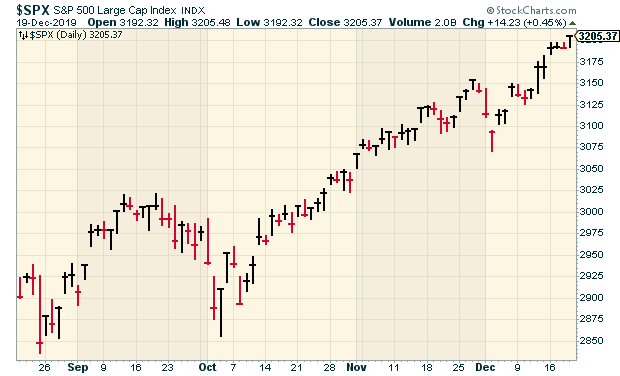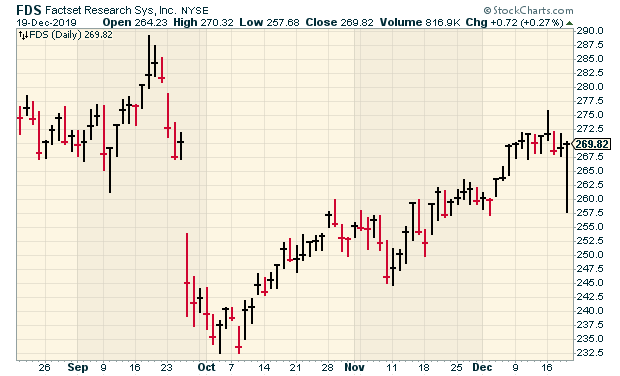CWS Market Review – December 20, 2019
“The secret to investing is to figure out the value of something and then pay a lot less.” – Joel Greenblatt
Reminder: I’ll send you the new 2020 Buy List on Christmas Day. As usual, five new stocks come in, and five old ones go out. This will be our 14th annual Buy List.
The 25 stocks are then equally weighted based on the closing prices on December 31. On January 1, I’ll send you another issue with all the tracking details.
Then the new Buy List goes into effect at the start of trading on January 2. After that, I can’t make any changes for another 12 months. It’s the same rules we’ve followed for 14 years.
President Trump Is Impeached and the Stock Market Shrugs
Now to this week’s market. For the third time in history, a president was impeached by the House of Representatives. Looking at share prices, Wall Street didn’t seem to care one way or the other.
The S&P 500 came within a hair’s breadth of closing higher for seven days in a row. A tiny 0.04% drop on Day #6 snapped the streak. On Thursday, the S&P 500 closed over 3,200 for the first time in history.
One of the big mistakes investors make is confusing financial markets with voting booths. Markets have rallied under both parties, and markets have dropped under both parties. Sometimes stocks just have a mind of their own. In the long run, it’s all about earnings and valuation.
It looks like the S&P 500 is about to wrap up another solid year. The index is currently up over 27.86% for the year. The S&P 500 has made 31 record highs this year.
So how does the market do after +20% years? Not so bad, actually. Since 1950, it’s happened 18 times, and in 15 of those years, the stock market has made a profit the following year. The average gain is 11.2%.
That’s not all. If the S&P 500 closes above 3,248.87 on December 31, then this would be the best year for stocks since 1997.
I don’t know how many people would have predicted that the stock market would have a low volatility and multiple new highs during an impeachment, but that’s exactly what’s happened.
The mood has shifted and investors seem much more confident than they did over the summer. Remember in August when the two-year Treasury yield jumped above the 10-year yield for about half an hour? The “inversion” scare was good for about a week, as market commentators talked about “being very concerned.”
Well, here we are a few months later, and the yield curve is back to normal. In fact, the 2/10 spread is now the steepest it’s been in over a year.
There’s been more good news about the economy. For example, Fannie Mae significantly boosted its housing forecast for next year. According to Fannie, “growth in single-family housing starts will accelerate to 10% during 2020 and top one million new homes in 2021.” Last month, mortgage applications to buy new homes were up 27% from last year.
Housing demand is very high, especially at the lower end of the market, and that’s exactly where builders have been least active. The recent report from the National Association of Home Builders showed homebuilder confidence is at a 20-year high. It’s even higher than it was during the housing bubble.
On Tuesday, we saw a nice rebound in the report in industrial production. This data hasn’t been very strong in recent years. Some of the recovery is due to the end of the GM strike, but that doesn’t explain all of it.
I’ve also noticed that credit spreads are tightening. In plain English, that means that lenders are willing to take on more risk. That’s actually good news, at first, since it means more borrowers have access to capital. This can eventually become a problem when too many folks find themselves in too much debt. For now, it’s good news and suggests that a recession isn’t imminent.
Now let’s look at our final Buy List earnings report for 2019.
FactSet Soundly Beats Earnings
On Thursday morning, FactSet (FDS) reported fiscal Q1 earnings of $2.58 per share. That was a 9.8% increase over last year, and it easily beat Wall Street’s estimate of $2.42 per share.
This is good to see, because FDS alarmed some investors three months ago when it gave rather unimpressive guidance for this fiscal year. The stock took a hit.
Let’s look at some numbers. For fiscal Q1, organic revenue grew 4.2% to $367.9 million. Annual Subscription Value (ASV) plus professional services, which is a key metric for FDS, came in at $1.48 billion. That’s the same as a year ago. I like that FactSet’s operating margin improved to 33.9%, compared with 31.5% last year.
At the end of the quarter, FactSet’s client count stood at 5,601. The company now has 126,785 users and 9,865 employees.
Even though FDS had a solid quarter, the company didn’t alter its conservative guidance. I suppose changing the numbers after one quarter might be too soon.
For what it’s worth, FactSet still expects full-year earnings to range between $9.85 and $10.15 per share, and revenue between $1.49 and $1.50 billion.
The stock dropped 4% at Thursday’s open, but gradually worked its way back, and FDS eventually closed Thursday in the green. This week, I’m raising my Buy Below on FactSet to $278 per share.
Buy List Updates
This week, Cerner (CERN) said its board approved the repurchase of an additional $1.5 billion in stock. The company had nearly exhausted its previous authorization of $1.5 billion.
Danaher (DHR) announced the results of its exchange offer for Envista (NVST). The deal was quite popular as it was oversubscribed by 15-fold. Not many folks got shares, but those who got them got a pretty good deal. The company also won conditional approval from the EU for its acquisition of GE’s biopharma business. Danaher will have to sell off some assets to appease the regulators.
I also want to make two more adjustments to our Buy Below prices. I’m lifting the Buy Below on Eagle Bank (EGBN) to $53 per share. The bank has made back two-thirds of what it lost during the big plunge in July. I’m also lifting Becton, Dickinson (BDX) to $275 per share.
That’s all for now. There won’t be many economic reports next week. The report on new-home sales comes out on Monday. On Tuesday, Christmas Eve, the stock market will close at 1 p.m. ET. The following day, the exchanges will be closed all day for Christmas. Also on Christmas, I’ll send you the new 2020 Buy List. Be sure to keep checking the blog for daily updates. I’ll have more market analysis for you in the next issue of CWS Market Review!
– Eddy
Posted by Eddy Elfenbein on December 20th, 2019 at 7:08 am
The information in this blog post represents my own opinions and does not contain a recommendation for any particular security or investment. I or my affiliates may hold positions or other interests in securities mentioned in the Blog, please see my Disclaimer page for my full disclaimer.
- Tweets by @EddyElfenbein
-
-
Archives
- April 2024
- March 2024
- February 2024
- January 2024
- December 2023
- November 2023
- October 2023
- September 2023
- August 2023
- July 2023
- June 2023
- May 2023
- April 2023
- March 2023
- February 2023
- January 2023
- December 2022
- November 2022
- October 2022
- September 2022
- August 2022
- July 2022
- June 2022
- May 2022
- April 2022
- March 2022
- February 2022
- January 2022
- December 2021
- November 2021
- October 2021
- September 2021
- August 2021
- July 2021
- June 2021
- May 2021
- April 2021
- March 2021
- February 2021
- January 2021
- December 2020
- November 2020
- October 2020
- September 2020
- August 2020
- July 2020
- June 2020
- May 2020
- April 2020
- March 2020
- February 2020
- January 2020
- December 2019
- November 2019
- October 2019
- September 2019
- August 2019
- July 2019
- June 2019
- May 2019
- April 2019
- March 2019
- February 2019
- January 2019
- December 2018
- November 2018
- October 2018
- September 2018
- August 2018
- July 2018
- June 2018
- May 2018
- April 2018
- March 2018
- February 2018
- January 2018
- December 2017
- November 2017
- October 2017
- September 2017
- August 2017
- July 2017
- June 2017
- May 2017
- April 2017
- March 2017
- February 2017
- January 2017
- December 2016
- November 2016
- October 2016
- September 2016
- August 2016
- July 2016
- June 2016
- May 2016
- April 2016
- March 2016
- February 2016
- January 2016
- December 2015
- November 2015
- October 2015
- September 2015
- August 2015
- July 2015
- June 2015
- May 2015
- April 2015
- March 2015
- February 2015
- January 2015
- December 2014
- November 2014
- October 2014
- September 2014
- August 2014
- July 2014
- June 2014
- May 2014
- April 2014
- March 2014
- February 2014
- January 2014
- December 2013
- November 2013
- October 2013
- September 2013
- August 2013
- July 2013
- June 2013
- May 2013
- April 2013
- March 2013
- February 2013
- January 2013
- December 2012
- November 2012
- October 2012
- September 2012
- August 2012
- July 2012
- June 2012
- May 2012
- April 2012
- March 2012
- February 2012
- January 2012
- December 2011
- November 2011
- October 2011
- September 2011
- August 2011
- July 2011
- June 2011
- May 2011
- April 2011
- March 2011
- February 2011
- January 2011
- December 2010
- November 2010
- October 2010
- September 2010
- August 2010
- July 2010
- June 2010
- May 2010
- April 2010
- March 2010
- February 2010
- January 2010
- December 2009
- November 2009
- October 2009
- September 2009
- August 2009
- July 2009
- June 2009
- May 2009
- April 2009
- March 2009
- February 2009
- January 2009
- December 2008
- November 2008
- October 2008
- September 2008
- August 2008
- July 2008
- June 2008
- May 2008
- April 2008
- March 2008
- February 2008
- January 2008
- December 2007
- November 2007
- October 2007
- September 2007
- August 2007
- July 2007
- June 2007
- May 2007
- April 2007
- March 2007
- February 2007
- January 2007
- December 2006
- November 2006
- October 2006
- September 2006
- August 2006
- July 2006
- June 2006
- May 2006
- April 2006
- March 2006
- February 2006
- January 2006
- December 2005
- November 2005
- October 2005
- September 2005
- August 2005
- July 2005


 Eddy Elfenbein is a Washington, DC-based speaker, portfolio manager and editor of the blog Crossing Wall Street. His
Eddy Elfenbein is a Washington, DC-based speaker, portfolio manager and editor of the blog Crossing Wall Street. His